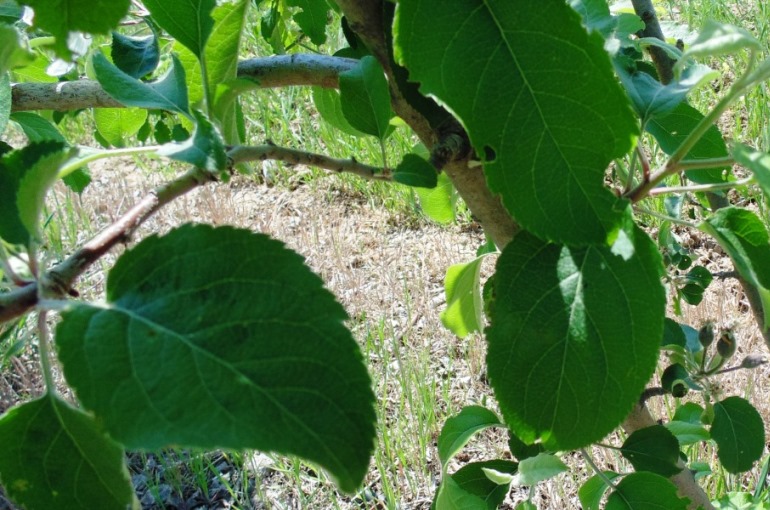Growing Apple Trees in Pots

This post is also available in:
This post is also available in:
![]() Español (Spanish)
Español (Spanish) ![]() Français (French)
Français (French) ![]() Deutsch (German)
Deutsch (German) ![]() Nederlands (Dutch)
Nederlands (Dutch) ![]() العربية (Arabic)
العربية (Arabic) ![]() Türkçe (Turkish)
Türkçe (Turkish) ![]() 简体中文 (Chinese (Simplified))
简体中文 (Chinese (Simplified)) ![]() Русский (Russian)
Русский (Russian) ![]() Italiano (Italian)
Italiano (Italian) ![]() Ελληνικά (Greek)
Ελληνικά (Greek) ![]() Português (Portuguese (Brazil))
Português (Portuguese (Brazil)) ![]() polski (Polish)
polski (Polish)
How to grow apple trees in containers
Growing apple trees in containers is governed by the nearly same rules as growing apple trees in the ground. The things to consider are the following:
1.) If you choose to grow an apple tree from seed, you will probably have to wait 7-10 years before harvesting your first apple. If you want to harvest apples in 1-3 years, you may have to follow the method used by nearly all the commercial apple growers, which is to buy grafted seedlings of 1-2 years old. You have to choose carefully the rootstock and the scion according to your region’s climate. Every apple tree variety has a minimum amount of cold needed in order to produce apples. Ask your local garden store.
2.) You have to choose a dwarf variety (the rootstock determines the final tree’s height). You have to be specific and clear to the merchant that you want an apple tree to grow in a container for the whole of its lifetime. There are many cases in which merchants sell standard height trees as dwarf or semi dwarf.
3.) Most apple varieties are self-infertile. If you plan to grow just one apple tree and you want to harvest fruits, you can choose a self-fertile variety. Alternatively, you can grow at a close distance two different trees of compatible varieties, with nearly the same period of flowering. Ask your local garden store.
4.) Choose a container at list twice as big as the tree’s root system. A 10 gallon (38 lt) container is a good start. You have to put the tree inside and fill the remaining container with soil mix and dirt. Keep in mind that the point where the scion is attached must be at least 3 inches (7,5 cm) above the ground level. All the containers are naturally built with small holes at the bottom, so that good drainage is ensured (you can also place broken clay pot pieces at the bottom of the pot for the same reason). You have to place the pot at a proper place of your yard, so that it will have full access to direct sunlight. Apple trees –just like nearly all fruit trees – need plenty of sunlight in order to produce fruits. You can move the pots in a protected but not too hot environment when freezing outside.
5.) You can water and prune your tree as soon as you plant it. Pruning is very important for the good aeration and health of the tree. Irrigation is the trickiest part when growing apple trees in containers. Many apple trees grown in pots have not survived due root rot from excessive water. Be very careful not to over-irrigate your tree. In general, apple trees need half of their annual water supply during July-August.
6.) You can add 1-4 lbs. (0,5-2 kg) of N-P-K 12-12-12 or 11-15-15 per young tree and 6,5 to 11 lbs. (3-5 kg) N-P-K 12-12-12 or 11-15-15 per mature tree (older than 5-6 years old) on annual basis. Fertilizers can be applied from March to July and the above mentioned quantities can be split into 2-3 applications. Read more on apple tree fertilization.
7.) Thinning is very important when growing apple trees. From spring to summer (April to July), we have to remove underdeveloped or unhealthy fruits as well as fruits that have been invaded by pests. We do this in order to leave valuable nutrients for the rest healthy fruits we want to harvest a couple of months later. We harvest apples in most cases from late summer to fall (August to October).
You can enrich this article by leaving a comment or photo of your apple tree grown in pot.
2.) Growing Apple Tree from seed
3.) Growing Apple Trees in pots
4.) Growing Apple Trees professionally
5.) Apple Tree Climate Conditions
6.) Apple Tree Propagation and Pollination
7.) Apple Tree Soil Conditions and Preparation
8.) Planting Apple Trees – Number of Apple Trees per Hectare
10.) How to fertilize Apple Trees
12.) Apple Tree Harvest & Yields
13.) Apple Tree Pests & Diseases
Do you have experience in Apple Tree cultivation? Please share your experience, methods and practices in the comments below. All the content you add will be soon reviewed by our agronomists. Once approved, it will be added to Wikifarmer.com and it will influence positively thousands of new and experienced farmers across the world.








































































